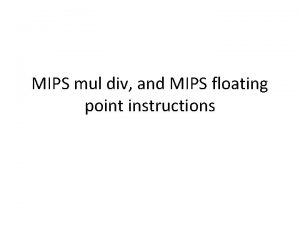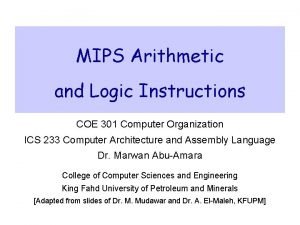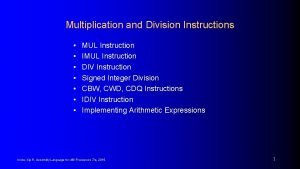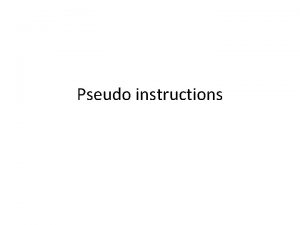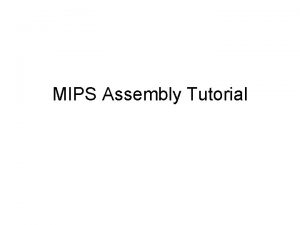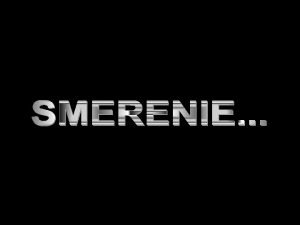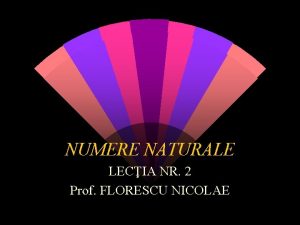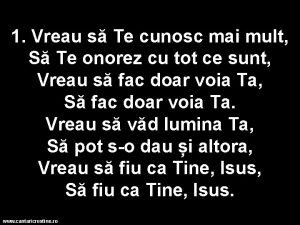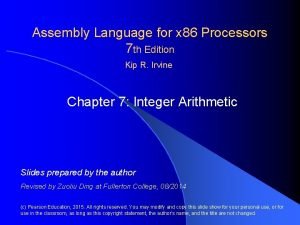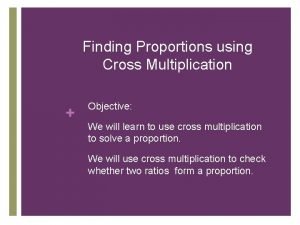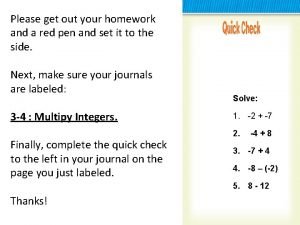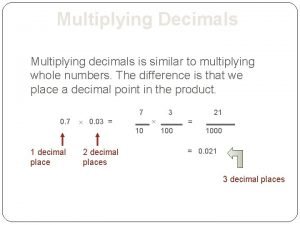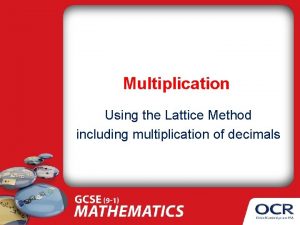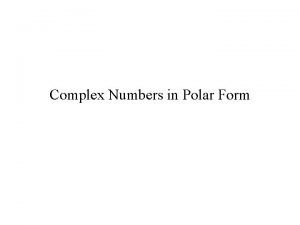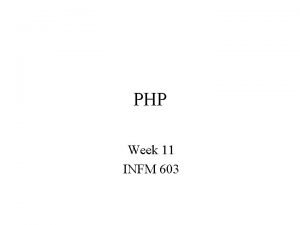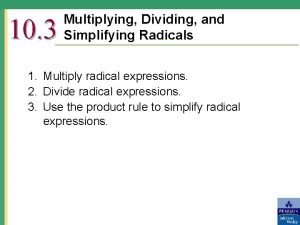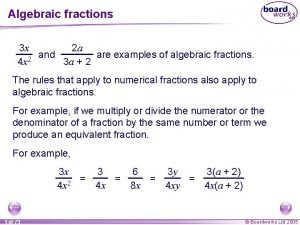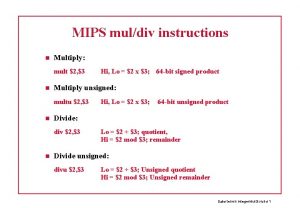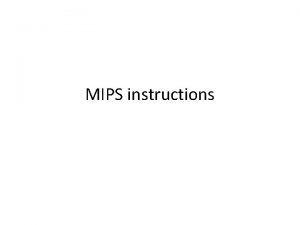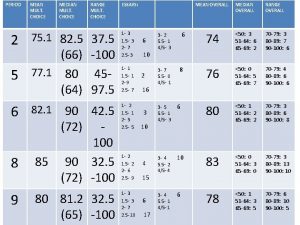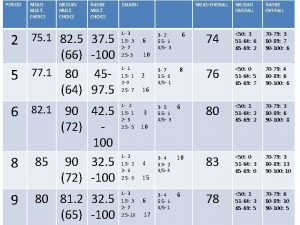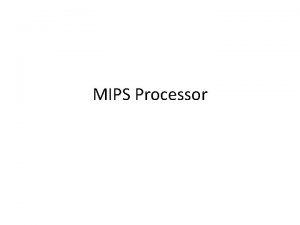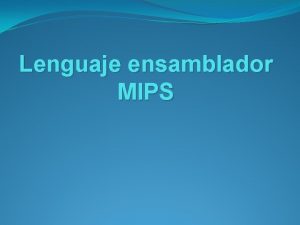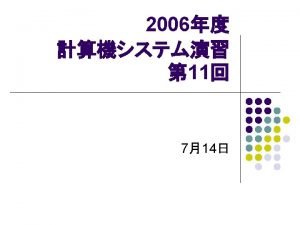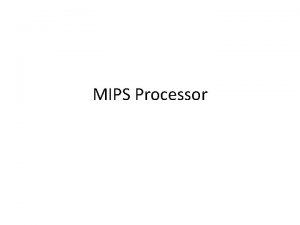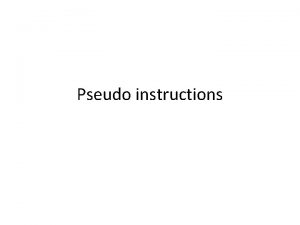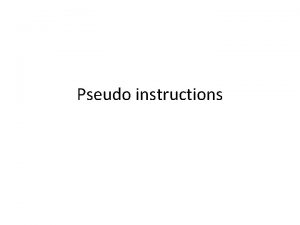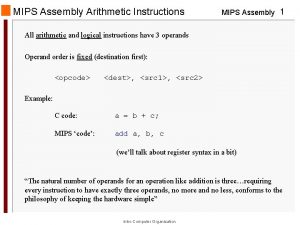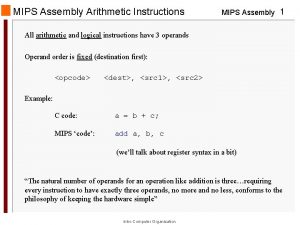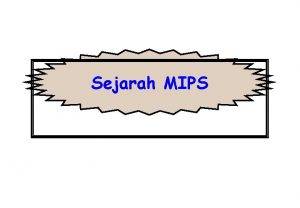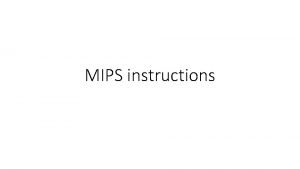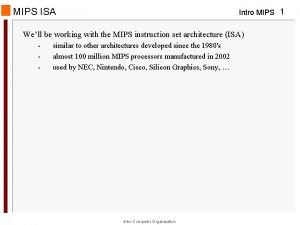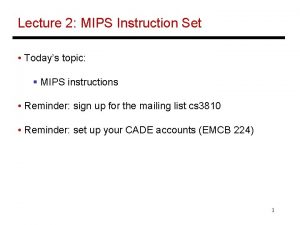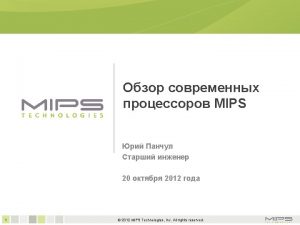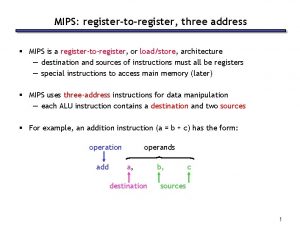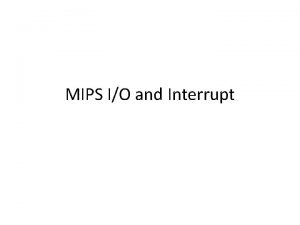MIPS muldiv instructions Multiply mult 2 3 Multiply
























- Slides: 24

MIPS mul/div instructions Multiply: mult $2, $3 Multiply unsigned: multu $2, $3 Hi, Lo = $2 x $3; 64 -bit unsigned product Divide: div $2, $3 Hi, Lo = $2 x $3; 64 -bit signed product Lo = $2 ÷ $3; quotient, Hi = $2 mod $3; remainder Divide unsigned: divu $2, $3 Lo = $2 ÷ $3; Unsigned quotient Hi = $2 mod $3; Unsigned remainder Datorteknik Integer. Mul. Div bild 1

MULTIPLY (Unsigned) Paper and pencil example (unsigned): Multiplicand 1000 Multiplier 1001 1000 0000 1000 Product 01001000 m bits x n bits gives m+n bit product Binary makes it easy: 0 => place 0 ( 0 x multiplicand) 1 => place a copy ( 1 x multiplicand) Datorteknik Integer. Mul. Div bild 2

Unsigned Combinational Multiplier 0 A 3 Stage i accumulates A * 2 i if Bi == 1 A 3 Q: How much hardware for a 32 bit multiplier? Critical path? A 3 P 7 P 6 A 2 A 1 P 5 A 2 A 1 0 A 0 B 1 A 0 B 2 A 0 P 4 B 3 P 2 P 1 P 0 Datorteknik Integer. Mul. Div bild 3

How does it work? at each stage: shift A left ( x 2) 0 use next bit of B to determine whether to add in shifted multiplicand accumulate 2 n bit partial product at each stage 0 0 A 3 A 3 P 7 P 6 A 2 P 5 A 2 A 1 P 4 0 A 3 A 2 A 1 0 A 0 B 1 A 0 B 2 A 0 P 3 B 0 B 3 P 2 P 1 P 0 Datorteknik Integer. Mul. Div bild 4

Flow Chart Start Test multiplier 0 Add multiplicand to product and And place result in Product register Shift multiplicand left 1 bit Shift multiplier right 1 bit Datorteknik Integer. Mul. Div bild 5

Unsigned shift-add multiplier (version 1) 64 -bit Multiplicand reg, 64 -bit ALU, 64 -bit Product reg, 32 bit multiplier reg Shift Left Multiplicand 64 bits Multiplier 64 -bit ALU Product Shift Right 32 bits Write 64 bits Control Multiplier = datapath + control Datorteknik Integer. Mul. Div bild 6

Observations on Multiply Version 1 1 clock per cycle => ≈ 100 clocks per multiply – Ratio of multiply to add 5: 1 to 100: 1 1/2 bits in multiplicand always 0 => 64 -bit adder is wasted 0’s inserted in left of multiplicand as shifted => least significant bits of product never changed once formed Instead of shifting multiplicand to left, shift product to right? Datorteknik Integer. Mul. Div bild 7

MULTIPLY HARDWARE Version 2 32 -bit Multiplicand reg, 32 -bit ALU, 64 -bit Product reg, 32 -bit Multiplier reg Multiplicand 32 bits Multiplier 32 -bit ALU 32 bits Shift Right Product 64 bits Control Write Shift Right Datorteknik Integer. Mul. Div bild 8

0 A 3 0 A 2 0 A 1 A 2 What’s going on? 0 A 1 B 0 Multiplicand stay’s still and product moves right! A 0 B 1 A 3 A 2 A 1 A 0 P 7 P 6 P 5 B 2 B 3 P 4 P 3 P 2 P 1 P 0 Datorteknik Integer. Mul. Div bild 9

Observations on Multiply Version 2 Product register wastes space that exactly matches size of multiplier => combine Multiplier register and Product register Datorteknik Integer. Mul. Div bild 10

MULTIPLY HARDWARE Version 3 32 -bit Multiplicand reg, 32 -bit ALU, 64 -bit Product reg, (0 -bit Multiplier reg) Multiplicand 32 bits 32 -bit ALU Shift Right Product (Multiplier) 64 bits Control Write Datorteknik Integer. Mul. Div bild 11

Observations on Multiply Version 3 2 steps per bit because Multiplier & Product combined MIPS registers Hi and Lo are left and right half of Product Gives us MIPS instruction Mult. U How can you make it faster? What about signed multiplication? – easiest solution is to make both positive & remember whether to complement product when done (leave out the sign bit, run for 31 steps) – apply definition of 2’s complement need to sign-extend partial products and subtract at the end – Booth’s Algorithm is elegant way to multiply signed numbers using same hardware as before and save cycles can handle multiple bits at a time Datorteknik Integer. Mul. Div bild 12

Motivation for Booth’s Algorithm 1. Example 2 x 6 = 0010 x 0110: 0010 x 0110 + 0000 + 0010 + 0100 + 00001100 shift (0 in multiplier) add (1 in multiplier) shift (0 in multiplier) ALU with add or subtract gets same result in more than one way: 6=– 2+8 0110 = – 00010 + 01000 = = 11110 + 01000 Datorteknik Integer. Mul. Div bild 13

Motivation for Booth’s Algorithm 2. For example: 00010 x 01110 + 00000 - 00010 + 00000 + 00010 00011100 shift (0 in multiplier) sub (first 1 in multpl. ) shift (mid string of 1 s) add (prior step had last 1) Datorteknik Integer. Mul. Div bild 14

Booth’s Algorithm Current Bit 1 1 0 0 Bit to the Right Explanation 0 1 1 0 Begins run of 1 s Middle of run of 1 s End of run of 1 s Middle of run of 0 s Example 0001111000 Op sub none add none Originally for Speed (when shift was faster than add) -1 Replace a string of 1 s in multiplier with an initial subtract when we first + 10000 see a one and then later add for the bit after the last one 01111 Datorteknik Integer. Mul. Div bild 15

Booths Example (2 x 7) Operation Multiplicand 0. initial value 0010 0000 0111 0 1 a. P = P - m 1110 1 b. 2. 3. 4 a. 0010 +1110 0111 0 1111 0011 1 1111 1001 1 1111 1100 1 +0010 0001 1100 1 0000 1110 0 4 b. 0010 Product next? 10 -> sub shift P (sign ext) 11 -> nop, shift 01 -> add shift done Datorteknik Integer. Mul. Div bild 16

Booths Example (2 x -3) Operation Multiplicand 0. initial value 0010 1 a. P = P - m 1110 1 b. 2 a. 2 b. 3 a. 3 b. 4 a 4 b. 0010 +0010 +1110 0010 Product next? 0000 1101 0 10 -> sub +1110 1101 0 shift P (sign ext) 1111 0110 1 01 -> add 0001 0110 1 0000 1011 0 shift P 10 -> sub 1110 1011 0 1111 0101 1 1111 1010 1 shift 11 -> nop shift done Datorteknik Integer. Mul. Div bild 17

Divide: Paper & Pencil Divisor 1000 result) 1001010 – 1000 10 Quotient Dividend Remainder (or Modulo See how big a number can be subtracted, creating quotient bit on each step Binary => 1 * divisor or 0 * divisor Dividend = Quotient x Divisor + Remainder Datorteknik Integer. Mul. Div bild 18

DIVIDE HARDWARE Version 1 64 -bit Divisor reg, 64 -bit ALU, 64 -bit Remainder reg, 32 -bit Quotient reg Shift Right Divisor 64 bits Quotient 64 -bit ALU Remainder 64 bits Shift Left 32 bits Write Control Datorteknik Integer. Mul. Div bild 19

Observations on Divide Version 1 1/2 bits in divisor always 0 => 1/2 of 64 -bit adder is wasted => 1/2 of divisor is wasted Instead of shifting divisor to right, shift remainder to left? 1 st step cannot produce a 1 in quotient bit (otherwise too big) => switch order to shift first and then subtract, can save 1 iteration Datorteknik Integer. Mul. Div bild 20

DIVIDE HARDWARE Version 2 32 -bit Divisor reg, 32 -bit ALU, 64 -bit Remainder reg, 32 -bit Quotient reg Divisor 32 bits Quotient 32 -bit ALU Shift Left 32 bits Shift Left Remainder 64 bits Control Write Datorteknik Integer. Mul. Div bild 21

Observations on Divide Version 2 Eliminate Quotient register by combining with Remainder as shifted left – Start by shifting the Remainder left as before. – Thereafter loop contains only two steps because the shifting of the Remainder register shifts both the remainder in the left half and the quotient in the right half – The consequence of combining the two registers together and the new order of the operations in the loop is that the remainder will shifted left one time too many. – Thus the final correction step must shift back only the remainder in the left half of the register Datorteknik Integer. Mul. Div bild 22

DIVIDE HARDWARE Version 3 32 -bit Divisor reg, 32 -bit ALU, 64 -bit Remainder reg, (0 -bit Quotient reg) Divisor 32 bits 32 -bit ALU “HI” “LO” Remainder Shift Left (Quotient) 64 bits Control Write Datorteknik Integer. Mul. Div bild 23

Observations on Divide Version 3 Same Hardware as Multiply: just need ALU to add or subtract, and 63 -bit register to shift left or shift right Hi and Lo registers in MIPS combine to act as 64 -bit register for multiply and divide Signed Divides: Simplest is to remember signs, make positive, and complement quotient and remainder if necessary – Note: Dividend and Remainder must have same sign – Note: Quotient negated if Divisor sign & Dividend sign disagree e. g. , – 7 ÷ 2 = – 3, remainder = – 1 Possible for quotient to be too large: if divide 64 -bit interger by 1, quotient is 64 bits (“called saturation”) Datorteknik Integer. Mul. Div bild 24
 Mips mult
Mips mult Mult mips
Mult mips Idiv assembly
Idiv assembly Li pseudo instruction
Li pseudo instruction Mips instruction format
Mips instruction format Pseudo instruction
Pseudo instruction Text nonliterar si literar
Text nonliterar si literar Demult sau de mult
Demult sau de mult Cine umbla mult prin lume si se striga pe nume
Cine umbla mult prin lume si se striga pe nume Potencia aparente
Potencia aparente Pe axa numerele mai mari sunt așezate mai mici
Pe axa numerele mai mari sunt așezate mai mici Vreau sa te cunosc mai mult acorduri
Vreau sa te cunosc mai mult acorduri Mult.asm
Mult.asm Solve proportions using multiplication
Solve proportions using multiplication Dividing fractions with decimals
Dividing fractions with decimals Lesson 4 multiply integers page 237 answers
Lesson 4 multiply integers page 237 answers How to multiply decimals
How to multiply decimals Subtract complex fractions
Subtract complex fractions Lattice multiplication with decimals
Lattice multiplication with decimals Rectangular form complex numbers
Rectangular form complex numbers Multiplying out brackets
Multiplying out brackets Function multiply(a, b){ a * b
Function multiply(a, b){ a * b Simplifying radicals worksheet doc
Simplifying radicals worksheet doc How to divide algebraic fractions
How to divide algebraic fractions
